Rear seat adjustment
Headrest

The rear seat is equipped with headrests for the occupant's safety and comfort.
The headrest not only provides comfort for passengers, but also helps to protect the head and neck in the event of a collision.

-
For maximum effectiveness in case of an accident, the headrest should be adjusted so the middle of the headrest is at the same height as the center of gravity of an occupant's head. Generally, the center of gravity of most people's head is similar with the height of the top of their eyes. Also adjust the headrest as close to your head as possible. For this reason, the use of a cushion that holds the body away from the seatback is not recommended.
-
Do not operate the vehicle with the headrests removed or reversed. Severe injury to an occupant may occur in the event of an accident. Headrests may provide protection against severe neck injuries when properly adjusted.
Adjusting the height up and down

To raise the headrest,
-
Pull it up to the desired position (1). To lower the headrest, push and hold the release button (2) on the headrest support and lower the headrest to the desired position (3).
Removal and installation
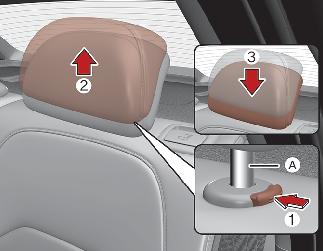
-
To remove the headrest, raise it as far as it can go then press the release button (1) while pulling upward (2).
-
To reinstall the headrest, put the headrest poles (A) into the holes while pressing the release button (1). Then adjust it to the appropriate height (3).

Make sure the headrest locks in position after adjusting it to properly protect the occupants.
Armrest (if equipped)
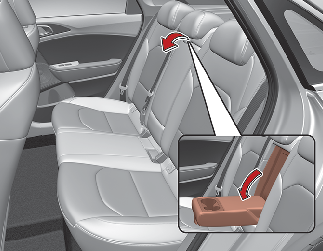
To use the armrest,
-
Pull it forward from the seatback.
Folding the rear seat
The rear seatbacks may be folded to facilitate carrying long items or to increase the luggage capacity of the vehicle.

The purpose of the fold-down rear seatbacks is to allow you to carry longer objects than could not otherwise be accommodated.
Never allow passengers to sit on top of the folded down seatback while the car is moving as this is not a proper seating position and no seat belts are available for use. This could result in serious injury or death in case of an accident or sudden stop. Objects carried on the folded down seatback should not extend higher than the top of the front seats. This could allow cargo to slide forward and cause injury or damage during sudden stops.
The rear seatbacks may be folded forward to provide additional cargo space and to provide access to the cargo area.
-
To raise the seatback, lift and push it firmly until it clicks into place.
-
When you return the seatback to its upright position, reposition the rear safety belts so that they can be used by rear seat passengers.

Do not fold the rear seat, if the driver's position is not properly set according to the driver's physical figure after folding the rear seat. A sudden stop or collision may cause injury.

-
When folding or unfolding the rear seat, make sure to move the front seat fully forward. If there are not enough space to fold the rear seat, never fold it by force. It will cause damage to the headrest or the related parts of the seat.
-
Before using the seat belt, be sure to remove it from the holder. If you pull out the seat belt while it's in the holder, it may damage the seat belt or holder.
-
Use the holder only when there is no passenger in the rear seat or when you need to fold the rear seat.

Blocked Hybrid battery duct
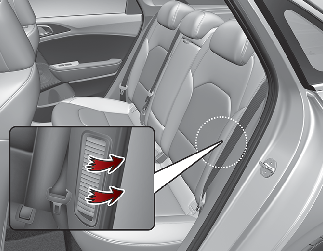
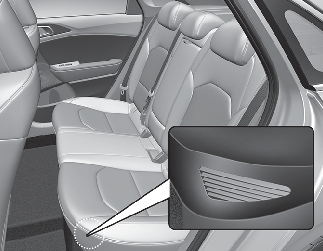
Do not put objects on the left side of rear seats. This could block the battery cooling duct causing battery degradation.
To fold down the rear seatback (if equipped)
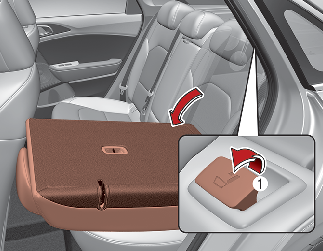

2nd row right side seat folding
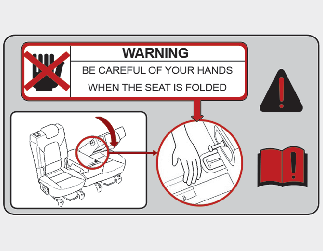
Be careful when you fold the 2nd row right side seat, if the center seat is folded. It may cause injury or damage to you.
To unfold the rear seat
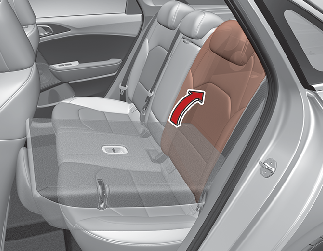
If you can not see the red line at the bottom of folding lever, it means the seatback is locked completely.
To fold down the rear center seatback separately (if equipped)
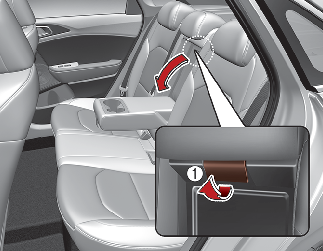
Long objects can be stored by folding the rear center seatback, without having to fold all rear seats. See below steps for folding the rear center seatback.

Uprighting seat
When you return the seatback to its upright position, hold the seatback and return it slowly. If the seatback is returned without holding it, the back of the seat could spring forward resulting in injury caused by being struck by the seatback.

After folding the rear seat, unless the driver’s position is properly set according to the driver’s physical figure, do not fold the rear seat. It may increase body injuries in a sudden stop or collision.

When you return the rear seatback to its upright position after being folded down:
Be careful not to damage the seat belt webbing or buckle. Do not allow the seat belt webbing or buckle to get caught or pinched in the rear seat. Ensure that the seatback is completely locked into its upright position by pushing on the top of the seatback. Otherwise, in an accident or sudden stop, the seat could fold down and allow cargo enter the passenger compartment, which could result in serious injury or death.

Damaging rear seat belt buckles
When you fold the rear seatback, insert the buckle between the rear seatback and cushion. Doing so can prevent the buckle from being damaged by the rear seatback.

Rear seat belts
When returning the rear seatbacks to the upright position, remember to return the rear shoulder belts to their proper position.

Cargo
Cargo should always be secured to prevent it from being thrown about the vehicle in a collision and causing injury to the vehicle occupants. Do not place objects in the rear seats, since they cannot be properly secured and may hit the front seat occupants in a collision.

Cargo loading
Make sure the engine is off, the dual clutch transmission is in P (Park) and the parking brake is securely applied whenever loading or unloading cargo. Failure to take these steps may allow the vehicle to move if the shift lever is inadvertently moved to another position.